Of the additional formatting options, the ability to create headers and footers is most often used. Headers and footers are areas located on the top and bottom margins of document pages. Headers and footers typically contain information such as the title of the document, subject, author's name, page numbers, or date. When using headers and footers in a document, you can place different text in them for even or odd pages, for the first page of the document, change the position of headers and footers from page to page, and so on.
To work with headers and footers in Word 2007, use the "Headers and Footers" panel of the "Insert" ribbon.
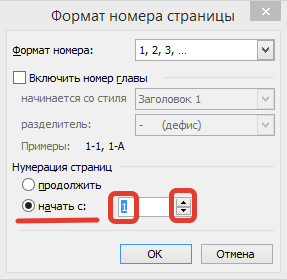
After insertion, the header and footer is available for editing, and the contextual ribbon "Designer" (Working with headers and footers) appears.
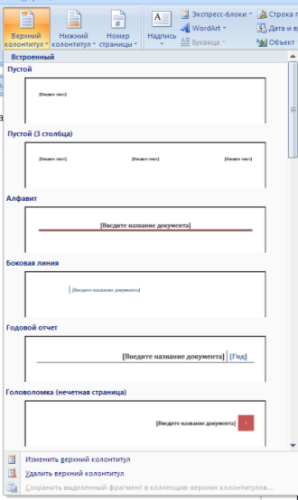

The edited header can be added to the header gallery using the "Save selection to header/footer collection" option.
Customizing the header
The "Constructor" ribbon of the "Working with headers and footers" contextual tool allows you to quickly make such settings for the header and footer, such as:
different headers and footers for even and odd pages;
a separate header for the first page;
hiding the main text while working with headers and footers;
insert and edit page number;
managing the position of the footer;
inserting various objects into the header: current date and time, pictures, building blocks, ClipArt objects.
Headers and footers can be configured separately for different sections. But, for this you need to break the connection between them, because. By default, all headers and footers are linked. To do this, you need to go to the header that needs to be formatted differently, and "press" the "As in the previous section" button.
If, on the contrary, there is a need to bring headers and footers in different sections to the same view, then the button "As in the previous section" should be "pressed".
A quick transition between the headers and footers and the main text of the document can be done by double-clicking on the desired element (header/footer or body text).
To remove headers and footers, use the "Delete header/footer" item of the corresponding header and footer buttons.
Pagination
Use the Page Number button (Insert ribbon, Headers and Footers panel) to number pages.
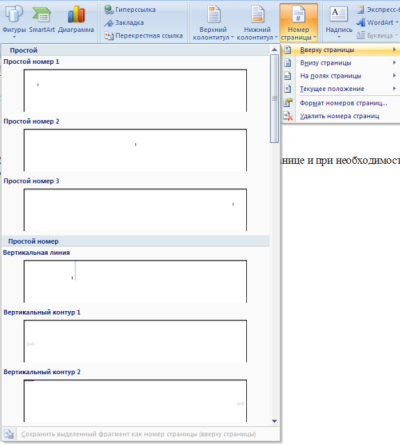
You must select the option for placing the number on the page itself and, if necessary, adjust the format of the number itself.
If necessary, page number elements can be saved by adding to the building blocks collection. To do this, after inserting and setting the number, press the "Page number" button and select the "At the top / bottom of the page" - "Save selection as page number" command.
If it becomes necessary to remove the number only from the first page, you need to do the following:
open the "Page Layout" ribbon;
open the Page Setup panel window;
on the "Paper Source" tab, check the box "Distinguish first page headers and footers " .

Practical work No. 2 Formatting a text document. Working with headers.
Goal of the work- studying the functionality of the Word 2007 word processor and acquiring practical skills in formatting text documents.
Changing character formatting options affects (in descending order of priority level):
a) the selected fragment of the text;
b) the unselected word pointed to by the text cursor;
c) characters that will be typed immediately after changing the formatting parameters (if the cursor does not move).
Task number 1
Open the Proba.docx file you created earlier
In the second paragraph, make the following changes using various formatting options (formatting requirements are in parentheses):
Input characters(Times New Roman, 14, K) appear in that place on the screen (Arial, 12, red, strikethrough), where is the cursor,(Arial Narrow,10,underlined) which shifts to the right, (Times New Roman,12,superscript) leaving behind a string of characters. (Times New Roman, 12, subscript) When reaching the right margin of the page (Times New Roman, 10, underlined, F, dark red, small caps, sparse by 0.25pt) the cursor automatically moves to the next line. (Monotype Corsiva, color fill - yellow, 12) THIS PROCESS IS CALLED(Arial Unicode MS, 12, F, all caps) Text Flow(Times New Roman, 12, K, red, start with capitals), and pressing the key ( Comic Sans MS , 20 ) E n t e r (Times New Roman, 12, spacing - sparse by 2pt, shifting each character down by 3pt, relative to the previous one) creates a new paragraph, (Times New Roman, 12, spacing - condensed by 1.5 pt) and not a new line .(Times New Roman, 12, double strikethrough, recessed)
As a result, your text should look like this:

Task number 2
Break the third paragraph of the text into two columns. As a result, the text should look like this:
Task number 3
Insert page numbers into your document:
Insert-Page Number-Top pages- Page X of Y- Bold numbers 3
Task number 4
Insert headers and footers into the document:
Insert - Footer - Conservative
Task number 5
Set the drop cap at the beginning of the fourth paragraph. As a result, you will get the following type of text:
Exit the program saving changes to the document
Programs related to the package Microsoft office, such as Word and Excel, provide the user with ample opportunities for editing documents. The inscriptions printed on each sheet in the header or at the bottom save a person from having to drive in information twice. However, there are times when this data is not needed and needs to be erased.
How to remove header and footer in Word 2003
Technology never stops evolving, and neither does software for computers. You may notice that the versions of Word and Excel released in 2003 are strikingly different in interface from their younger counterparts. There are differences in the functionality of the programs, they also affect the headings. How to remove headers and footers in Word 2003, this simple algorithm will tell you:
- Activate the "Headers and Footers" submenu from the "View" drop-down menu by double-clicking on the text to be deleted. Note that the cursor and labels are inside the dotted box.
- Highlight all unnecessary information with the cursor.
- Press the Del key or use the Cut command.
It is worth highlighting that after these actions, the header data will disappear from all sheets of the document on which they were previously created. However, if you only removed the labels from the top margin, the bottom entries or page numbers will remain intact. To completely remove them from open file you will need to repeat the process for the dotted box below by double-clicking on it.
How to remove headers and footers in Word 2010
More than 10 years have passed since the release of the text editor in 2003. For that Microsoft time Office has been modernized both functionally and externally. Work with sections Microsoft Word 2007, 2010, and then 2013 release became somewhat more convenient, although the visual differences from the previous version are striking. However, in these programs you can perform the same actions, but different ways. For example, this instruction will help you figure out how to disable headers and footers in Word 2010:
- It is not difficult to distinguish heading data that is common for the entire document or its parts from the body text. The color of letters and logos, if present, will be more subdued.
- Click on the caption twice. You will not see a frame in this version, the border for the main text is a dotted line.
- A new submenu "Designer" will appear on the taskbar, where you can edit the entry if you wish. However, to remove information or part of it, you will need to select the text and press the Del key.
A similar algorithm works not only for the 2010, but also for the 2007 version of the editor. For these programs, in addition to standard actions with headers and footers added and other options. For example, the Express Blocks submenu will help automate the process of inserting information and visually diversify the document. Among the available options, you can choose not only top or bottom inscriptions, but also side ones, located on the right or left, depending on the markup.
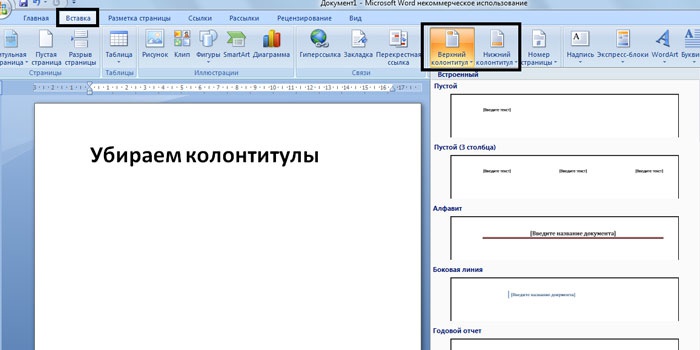
Working with headers and footers
It is not uncommon, especially if we are talking about student papers, when it is required to correct the document only partially, leaving the main material unchanged. This is where the questions about working with Word editors and Excel. For those who are just starting to work with these programs, it is often not clear how to remove the header and footer from the second page, leaving it on the rest. However, the possibilities of these famous editors allow these and similar actions.
How to remove the header in Word
The data located on top, as a rule, is designed to report some important information, coordinates, rubric names. They can be the same for each section, or different if necessary. The header area often contains the following data:
- Name of the organization;
- job title;
- company logo;
- name, address and telephone number of the author;
- the date the document was written;
- brief annotation or a quote.
When this or other information is not needed and needs to be removed, knowledge of the intricacies of a text editor comes to the rescue. How to remove the header in Word is clear from this algorithm:
- Double-click the left mouse button, hovering over the lighter text at the top.
- In the "Designer" tab that appears on the left, select the "Header" submenu, and then go down to the very bottom to select the "Delete" command.
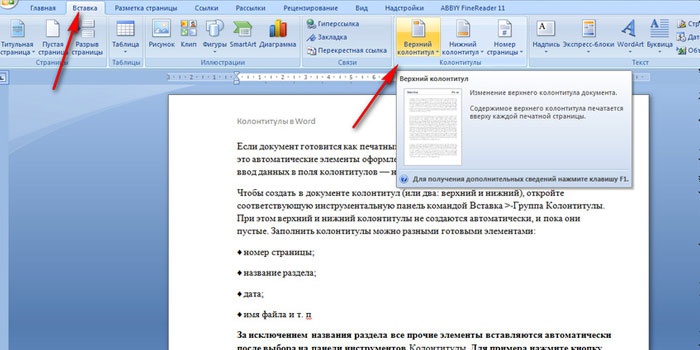
How to remove the footer in Word
Information placed at the bottom of the document is more common. There may not be data in the page header, but the footer, especially for large files, is almost always present. The fact is that at the bottom of the sheet: on the left, in the center or on the right, page numbers are placed. Occasionally, this information is supplemented by the title of the work and the name of the author, the title of the section. It is easy to remove such information along with the numbering of sheets. in the following way:
- Click on the text at the bottom of the page (double click).
- Select all unnecessary and remove with the Del key or in the "Footer" submenu, select the "Delete" command.
How to remove header and footer from last page
Upon completion of writing a term paper or thesis the authors indicate the sources used. The same design is acceptable for scientific works or books. The heading data required for the previous sections is out of place on the last sheet of the file. To correct the situation, follow this algorithm:
- Position the cursor after the final sentence, select the Page Layout tab, then the Breaks submenu and the Next Page command.
- At the created final sheet, find the headers and footers, double-click on them.
- In the "Designer" tab that appears after clicking, turn off the "As in the previous section" option.
- Activate the "Delete" command inside one of the submenus for the header or footer.
- Type the main text on the final page.
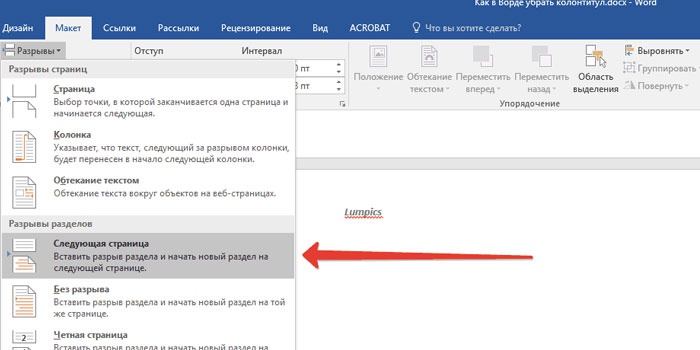
How to remove the header from the first page
The title page of any document must be in a certain way, no extra information, whether it is a page number or a section title, should not be present on it. Beginners who start working in text editor, should know that it is possible to automate the process of removing unnecessary data from the first page. How to remove headers and footers in Word, the instruction will tell you:
- Before creating the title page, place the cursor before the beginning of the first sentence of the body text.
- Go to the "Page Layout" tab, go to the "Breaks" submenu and click "Next Page".
- Double-click on the header and footer on the next sheet, after the title page. Disable the "As in the previous section" option.
- Make a couple of clicks on the inscription on the first page and delete it (Del or using the appropriate submenu).
Video: how to remove headers and footers
After watching this two minute video, you will know how easy it is to number an entire document. Pagination in Word program 2003 is very easy to do!
To number your work from the first to the last sheet, from the number 1, go to the Insert Menu - Page Numbers. In the dialog box, make settings for the location of the page number in the document: at the top or bottom of the page, left, right, or centered. Check the box Number on the first page. Go to the Format tab to set the settings on the Start from 1 switch. Here you can also set the number format. Save your settings by clicking OK. And once again OK in the main dialog box. Your document is now numbered.

Delete pagination Can ,
double-clicking on any number on any page with the left mouse button.  And then select the number itself in the same way. Press the Delete or Backspace key. Exit Header Mode by double-clicking anywhere in the document.
And then select the number itself in the same way. Press the Delete or Backspace key. Exit Header Mode by double-clicking anywhere in the document.
The figure can format as plain text, after selecting it and going to Menu Format - Font. You can make it larger or smaller, bold or italic, white on a black background using the buttons on the format bar. But still it will be different in color from the text in the document.
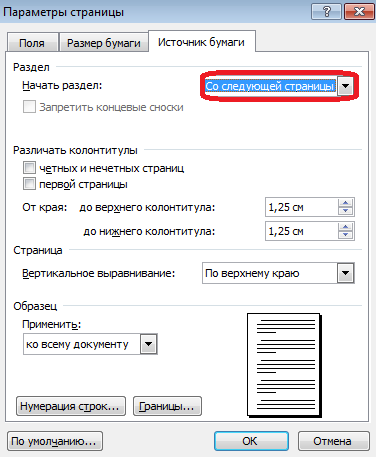 For the numbering to be outside the page
, place the cursor in front of the number and move it with the Tab key.
For the numbering to be outside the page
, place the cursor in front of the number and move it with the Tab key.
To start numbering from the second page number 1, do not check the FIRST PAGE NUMBER box. And in the FORMAT tab, select a convenient number format. In the START WITH switch, correct the number to zero. Don't forget to click OK.
HEADERS
Headers and footers decorate your work and exude professionalism. In the headers and footers, we can write any text and format it like any other text in Worde. The content of the footer can be format, like regular text. You can align left, right, or center using the buttons on the Formatting Bar. Make it bold, italic or underlined. But it still won't be as pronounced as the rest of the text in the document.
Headers can have
document's name
section name
author's name
date of creation
page number
contact
quote
table
drawing
and so on
The title of the document may be written in the header, and the page numbering in the footer. Or in the header on the left is the name of the document, and on the right is the page number.
Go to Menu View - Header and Footer and check the box next to Header and Footer. Decide where you want to place it, top or bottom. Place the cursor in the header or footer. Or use the Header/Footer button on the Header/Footer panel.
Different headers and footers in one document
To in title page headers and footers were distinguishable from others
,
do the following. In the File Menu - Page Setup, on the Paper Source tab, check the box Start Section From next page. In the Distinguish headers and footers field, check the First page checkbox and click OK. Or go to the View Menu - Headers and Headers and configure the page settings from the Headers and Footers panel by clicking on the button  Page settings. Double-click at the top or bottom of the first page in the header and footer field and make them empty or not like the others. Separately create a header and footer for all other pages.
Page settings. Double-click at the top or bottom of the first page in the header and footer field and make them empty or not like the others. Separately create a header and footer for all other pages.
Different headers and footers on even and odd pages . In the File menu - Page setup in the tab Paper source - Distinguish between odd and even page headers and footers, check the box. Create header and footer once on even and once on odd page and get autocomplete throughout the document.
Pagination from third page in Word 2003
Watch the video in which I will show you how to make numbering from any page of your document. With this method, you can make pagination only where it is needed.
We will share your Text Documentinto two sections: pages without numbers and with numbers. Let's set a gap between them. To make it clearer, we activate the Non-printing characters button on the Standard toolbar.
Let's put the cursor on the last line of the second page. Let's go to Menu Insert - Break. In the dialog box, select the radio button New section from the next page. Click OK. The cursor will jump to next page and will appear extra line, which must be deleted immediately so that the main text does not move. The section break icon will also appear, which we see because we have visible non-printable characters. In normal mode, the gap is not visible. If it's necessary remove page break,
place the cursor at the beginning of this gap and press the Delete button.
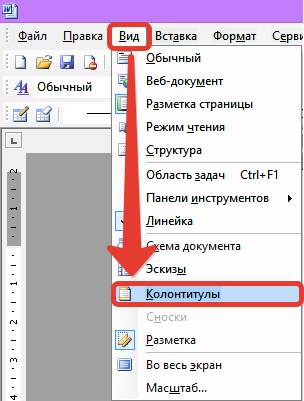 We enter the mode of creating headers and footers Menu View - Headers and footers. To go to the footer, click in the footer or use the Header/Footer button on the footer panel
We enter the mode of creating headers and footers Menu View - Headers and footers. To go to the footer, click in the footer or use the Header/Footer button on the footer panel
We have Section 1, Section 2, Header Panel and the label As in the previous one.
When you hover over the buttons of the Header Panel, pops up short title buttons. Button AS IN THE PREVIOUS is now active, which means that the connection between the sections is preserved. We need to press it so that we have page numbers only in the current second section.
Click the Format Page Number button in the dialog box. Check the box Start at 1. If you want the numbers on the first two pages to be invisible, check the box Start at 3. OK. You can now click the Insert Page Number Field button.
Exit the header and footer creation mode by double-clicking the left mouse button anywhere in the document.
Remove page numbering at the end of a document
Place the cursor on the sheet where you want to remove the page number. Enter the mode of headers and footers Menu View - Headers and footers. Go to the header or footer. It depends where the number is. On the panel for creating headers and footers, uncheck the button As in the previous one, and then delete the number itself. This way you can remove pagination only on the pages you want.
If there are several such sheets, then go to the desired header of each sheet, cancel As in the previous one and delete the number.
Now you know how pagination is done when working with a Word document and how pagination is removed from some pages.
How to Number All Lines in a Word 2003 Document
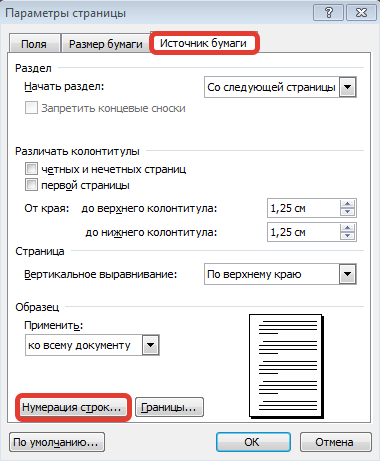 When working with a document in a program Word numbering lines are done in order to view and remove empty lines. In some cases, in order to accurately indicate the place (line) in the document where the necessary information is contained.
When working with a document in a program Word numbering lines are done in order to view and remove empty lines. In some cases, in order to accurately indicate the place (line) in the document where the necessary information is contained.
Go to File Menu - Page Setup to the Paper Source tab. Click the Line Numbering button. A dialog box will open where you need to check the box Add line numbering. The settings in this window help you start counting from the number you want. Indent as far away from the text as you like. Take the step you need. For example, if step 1, then the numbers will be 1,2,3,4, ... If step 2, then the numbers 2,4,6,8, ... If step 3, then 3,6,9, ... It depends on your goals . And yet, if you just need to number the lines in a row, then use step 1, that is, do not change anything.
Other settings.
If you set the switch opposite the item On each page, then on each new page line numbering will start over.
If the switch is In each section, then, accordingly, in each new section (if you have them) there will be a new line numbering.
If you put the switch on Continuous, then the line numbering from the beginning to the end of the document will not be interrupted.
Click on the OK button in this 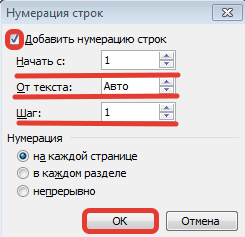 window, and after it closes Ok in the previous window. Immediately after that, the lines in the document will be numbered. Moreover, if you add or delete lines, the numbering will change automatically.
window, and after it closes Ok in the previous window. Immediately after that, the lines in the document will be numbered. Moreover, if you add or delete lines, the numbering will change automatically.
You can cancel line numbering by unchecking the Add line numbering check box.
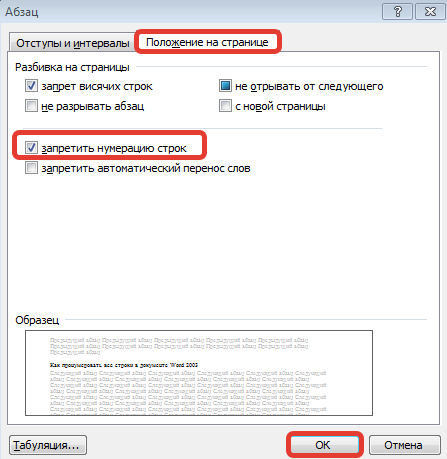 If necessary, in a part of the text that is already numbered, do lines without numbering, then first you need to select this part. Go to Menu Format - Paragraph tab Position on the page. Check the Disable line numbering checkbox. OK.
If necessary, in a part of the text that is already numbered, do lines without numbering, then first you need to select this part. Go to Menu Format - Paragraph tab Position on the page. Check the Disable line numbering checkbox. OK.
Header setting.
Headers and footers
A header or footer is a graphic or textual information that is located at the top or bottom of the page (above the top or below the bottom margin). Most often, headers and footers indicate the title of the chapter, the number of the section, the author of the book and the element of graphic design. The latter is added in order for the user to remember the graphic element, which, as a rule, carries a symbolic meaning. Especially bright examples this can be seen in works with rich artwork, such as in the adventure/fantasy genre.
A well-designed and visually aesthetic header and footer is the hallmark of a document. Spending a little time creating a header and footer will greatly increase the attractiveness of the document and improve its readability somewhat.
A footer can be created for each section of a document. But keep in mind that working with the header and footer is available only in page layout mode. Odd and even page headers and footers can be different, and header text can be formatted with virtually no restrictions.
Adding a Header
1st way.
Go to the "Insert" tab and in the "Headers and Footers" group, click the "Header" button;
In the drop-down list of ready-made header and footer samples, select the one you need. After clicking on it, you will be taken to the header and footer creation area (the “Designer - Working with headers and footers” tab will automatically open, and special groups and buttons for working with headers and footers will be displayed on the ribbon), while the main text will be colored in grey colour and will not be available for editing;
Figure 1. Ribbon with the open tab "Designer - Work with headers and footers".
Enter the required information in the area header. By default, it is entered with left alignment. To change this, use the following methods:
Go to the "Home" tab and in the "Paragraph" group, click on the desired text alignment buttons;
Use hotkey combinations: to align left -
Press key
After setting the header and footer, to close the header and footer window, click the Close Header Window button in the Close group, or double-click anywhere on the page.
2nd way.
Right-click in the top margin area, then click Edit Header.
Adding a footer is similar.
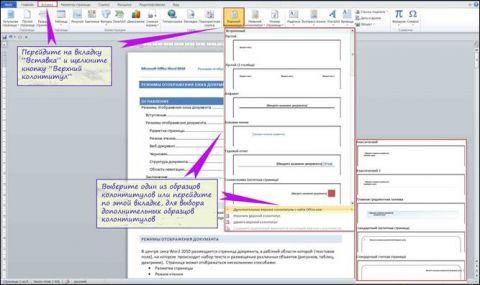
Figure 2. Header selection.
Editing headers and footers
1st way.
In the window open document double-click in the area of the desired footer. The header area will go into the formatting process, and the main text will become uneditable (grayed out);
Make the necessary changes.
2nd way.
"Insert" tab - in the "Headers and Footers" group, click the button for changing the document's header and footer;
In the window that opens, select the "Change Header (Footer)" tab;
After making changes, click Close Header Window or double-click anywhere on the workspace.
Hiding body text when working with headers and footers
Sometimes it's necessary to focus solely on working with the header and footer, and the contents of the work area can be distracting, especially if it is rich in drawings, decorated text, and photographs. In this case, it can be hidden. For this:
Open the tab "Constructor - Working with headers and footers" in one of the above ways;
In the "Options" group, uncheck "Show Document Text"
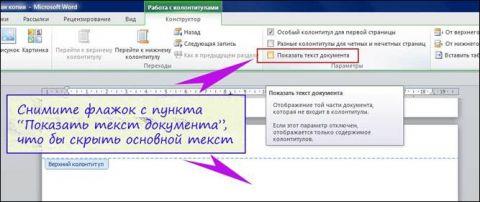
Figure 3. Hiding the main text.
Transition between headers and footers
Sometimes when editing a header area, you may want to quickly transition from the header to the footer (or vice versa). For this:
In the "Transitions" group, click the "Go to Header" and "Go to Footer" buttons to navigate to the respective header/footer editing areas.
If the document is divided into several sections, headers and footers may exist for each of them. In this case, the transitions are carried out as follows:
Go to the tab "Designer - Work with headers and footers";
In the Transitions group, click the Previous and Next Entry buttons to navigate forward and backward, respectively.

Figure 4. Navigation buttons between independent section headers.
If you want the headers and footers of the current section to be formatted in the same way as the previous section, click the "As in the previous section" button.
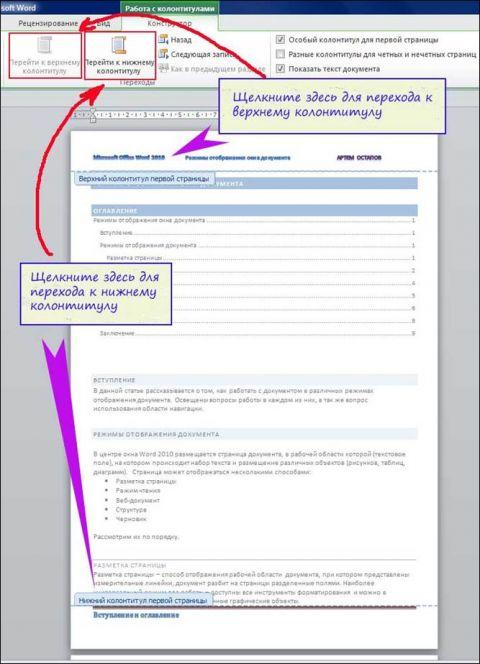
Figure 5. Transitions between headers and footers.
First page footer
In most documents, it is customary to distinguish between the headers and footers of the first and other pages. This is due to the fact that the first header, as a rule, reflects the main information about the document, such as the author or the title of the book, article. It is not at all necessary to reflect this in the headers and footers of the following pages, since they are often reserved for the titles of chapters and parts. In this case, you need to set separate header for the first page:
After creating the desired headers and footers, on the first page of the document, click in the header or footer area (depending on which one you want to create);
In the Options group, check the box next to Special header for the first page", and then enter the required data in the header and footer area;
Exit the header and footer editing mode by double-clicking in the document workspace.
Even and odd page footers
Different headers and footers for even and odd pages are often used in books, with the title of the work at the top of the left page spread and the title of the chapter at the top of the right page. Differences between odd and even page headers apply to the entire document. That is, a different header for a separate section of the document can be set using the “Special First Page Header”, but in the case of even / odd page headers, the changes will be common for the entire document.
In the "Options" group, check the "Distinguish between odd and even page headers" box.
Changing the spacing between the header data entry field and the edge of the page.
The standard (default) distance between the header data entry field (in the header area) and the edge of the page is 1.25 cm (about half an inch). The default value does not always match what you are looking for, so you must specify a different value:
Go to the tab "Designer - Work with headers and footers" in one of the above ways;
In the "Position" group, in the fields for setting the distance between the edge of the page and the data entry area of the header, enter the desired value. For the header in the field "From the top edge to the header", for the footer - in the field "From the bottom edge to the footer";
Close the header and footer editing area by double-clicking on the document workspace. At the same time, you will close the “Designer - Work with Headers and Footers” tab and automatically go to the “Home” tab.
Please note that if you enter a new line (by pressing "Enter"), the height of the header and footer area is automatically increased by the line height (it depends on the font size and line spacing).
If you need to add a placeholder or set justification, use the Aligned Tabs window. To do this, in the Position group, click Insert Aligned Tabs. In this window you can:
adjust alignment relative to margin or indent;
align text left/right or center;
choose one of the five placeholders (they are relatively infrequent, but still used to create chapter and section headers and footers in a document).
![]()
Figure 6. Changing the distance between the edge of the page and the header and footer field.
Inserting additional elements in the header
You can add not only text data to the header, but also various pictures, shapes, date and time, etc.
In order to insert one or another element in the header area, do the following
Double click in the header area;
In the "Insert" group, select and paste the object you are looking for by clicking on the corresponding group button;
Close the header and footer editing area.
There are four buttons in the "Insert" group:
"Picture" - places a picture in the header;
"Date and time" - inserts into the header current date and time;
"Picture" - places an image in the header;
"Express Blocks" - places autotext elements in the header.
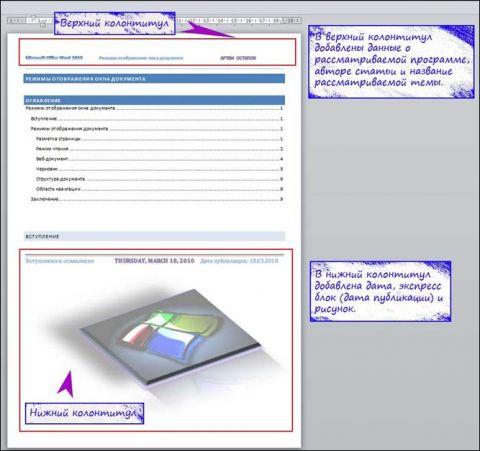
Figure 7. An example of headers and footers design.
Removing a header and footer
If you have unsuccessfully composed the header and footer, and it is easier for you to delete it than to edit it, you can easily do it.
1st way:
Go to the header editing area;
Highlight the entered data, and then delete it by pressing the "Delete" key.
2nd way:
Insert tab - in the Headers and Footers group, click the Header (Footer) button;
3rd way:
Double-click in the header area.
In the Header (Footer) group, click on the "Header (Footer)" button
In the window that opens, click on "Remove Header (Footer)".
